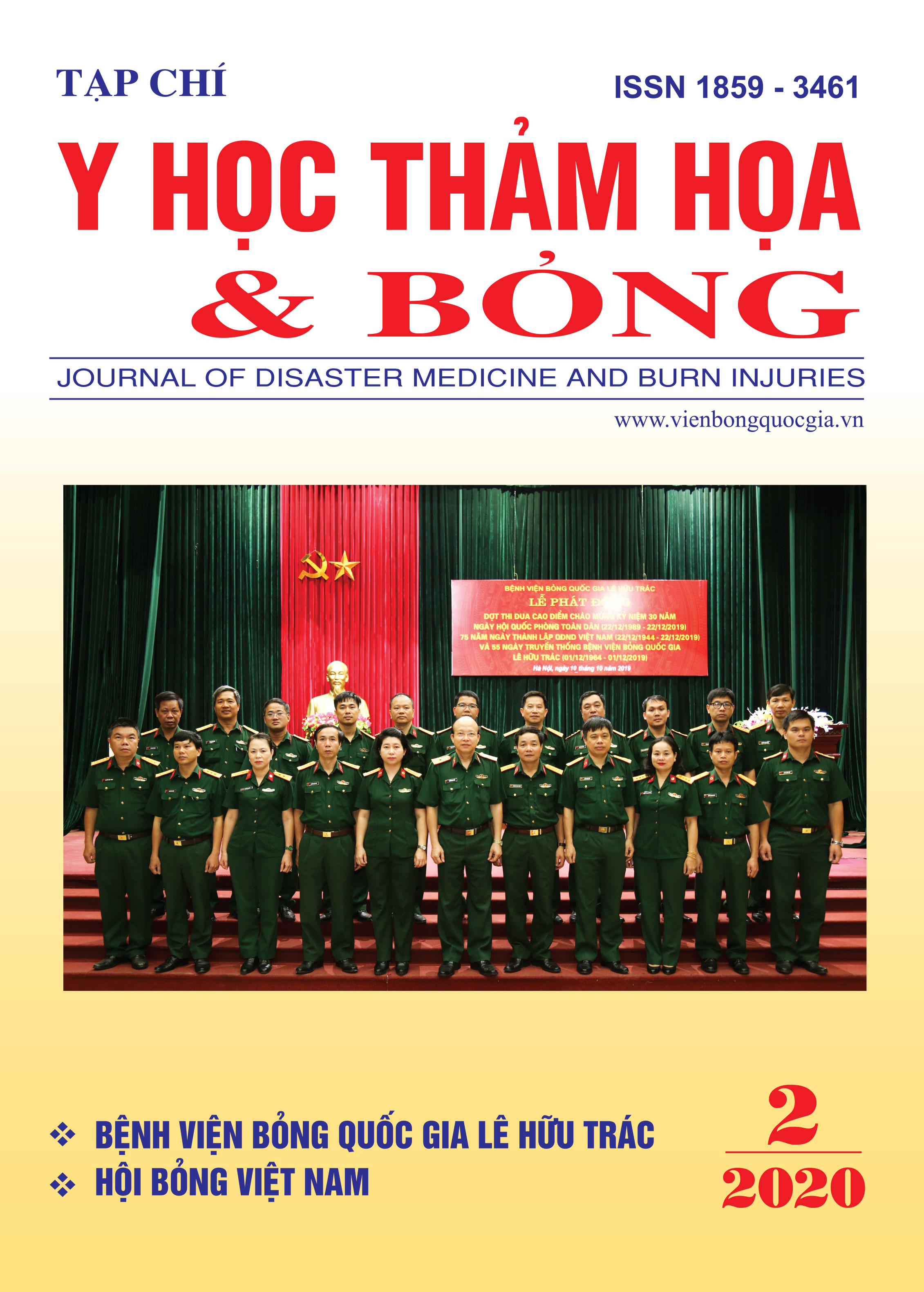Characteristics of burned soldiers treated at national burn hospital in 10 years (2008 - 2017)
Main Article Content
Abstract
Introduction: This study aims to comment on some epidemiological and outcome characteristics of burned soldiers from 2008 to 2017 at Vietnam National Burn Hospital.
Materials and methods: Retrospective, statistical and descriptive research based on 311 medical records of burned soldiers from January 1, 2008 to December 31, 2017 at the National Burn Hospital.
Result:
The male-to-female ratio was 8.4/1 (98.39% / 10.61%). 53.4% of burn schools belong to the working division at the school grounds and workshops. Non-commanding officers were the group with the highest burns (38.6%). The cause of burns was mainly due to fire and wet heat (43.09%, 24.76%). Mainly due to domestic accidents, occurring in places other than the workplace (75.2%, 74.6%). Patients mainly was burned slightly (accounting for 54.02%). Combined injuries accounted for 1.61%. Inhalation burns accounted for 2.25% of all military burns. The first aid rate was 71.7%, at the factory was 61.4%. Burns from labor accidents rate was the highest when working in factories whose severe burn patients rate was the highest.
The average length of hospital stay was 17.04 ± 15.25 days. The length of hospital stay was prolonged with electric burn patients (27.79 ± 21,124 days, p < 0.01), large burn areas, large full-thickness burns areas, and first-aid were not correct. The average number of surgeries in full-thickness burn patients was 2.33 times. Higher in patients was non-commanding officer, electric burns, burns due to fire, moderate and severe burns, large burns areas, large full-thickness burns areas. The mortality was 1.9% (100% are fire burns, common burn areas over 40% of total body surface area, full-thickness burns areas > 10% of total body surface area).
Conclusion: The non-commanding officer was the group of the most burnt subjects, the risk of burns due to labor accidents working in factories, factories and severe burns. First aid knowledge of burns in military personnel needs more improvement and prevention must be better with the cause of electric and fire burns.
Article Details
Keywords
Epidemiological characteristics, outcome, soldier, burn
References
2. Trần Đoàn Đạo (2015) Tình hình điều trị bỏng và di chứng bỏng tại bệnh viện Chợ Rấy trong 3 năm 2012 - 2014. Y học thảm họa và Bỏng, 2/2015, 25-29.
3. Yao Y., Liu Y., Zhou J.. et al. (2011) The epidemiology of civilian inpatients’ burns in Chinese military hospitals, 2001-2007. Burns, 37 (6), 1023-1032.
4. Ahachi C., Fadeyibi I., Chira M.. et al. (2017) The socio-economic impact of burns in Lagos, Nigeria: a one-year prospective study. Annals of Burns and Fire Disasters, 30 (3), 205.
5. D'arpa N., Napoli B. and Masellis M. (1993) The influence of a variety of parameters on the outcome of the burn disease in elderly patients. Diabetes, 8, 3.1.
6. Garmel G. M. and Mahadevan S. V. (2012) An introduction to clinical emergency medicine, Cambridge University Press,
7. Hwee J., Song C., Tan K. C.. et al. (2016) The trends of burns epidemiology in a tropical regional burns centre. Burns, 42 (3), 682-686.
8. Iqbal T., Saaiq M., and Ali Z. (2013) Epidemiology and outcome of burns: early experience at the country's first national burns centre. Burns, 39 (2), 358-362.
9. Li H., Yao Z., Tan J.. et al. (2017) Epidemiology and outcome analysis of 6325 burn patients: a five-year retrospective study in a major burn center in Southwest China. Scientific reports, 7, 46066.
10. Wardhana A., Basuki A., Prameswara A. D. H.. et al. (2017) The epidemiology of burns in Indonesia’s national referral burn center from 2013 to 2015. Burns Open, 1 (2), 67-73.
11. Ye C., Wang X., Zhang Y.. et al. (2016) Ten-year epidemiology of chemical burns in western Zhejiang Province, China. Burns, 42 (3), 668-674.
12. Xiaoming Fan, Ma B., Zeng D.. et al. (2017) Burns in a major burns center in East China from 2005 to 2014: Incidence and outcome. Burns, 43 (7), 1586-1595.


